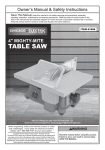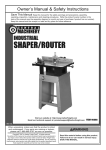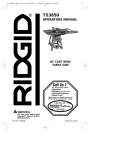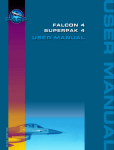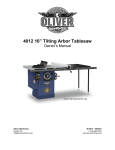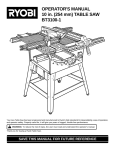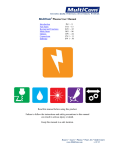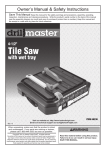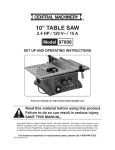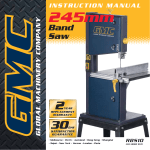Download Harbor Freight Tools 10 in., 13 Amp Benchtop Table Saw Product manual
Transcript
Table of contents SAFETy Safety ......................................................... 2 Setup .......................................................... 7 Specifications ............................................. 8 Operation ................................................... 12 Maintenance .............................................. 15 Parts List.................................................... 18 Assembly Diagram .................................... 19 Warranty .................................................... 20 WARNING SyMBOLS AND DEFINITIONS SETUP This is the safety alert symbol. It is used to alert you to potential personal injury hazards. Obey all safety messages that follow this symbol to avoid possible injury or death. Indicates a hazardous situation which, if not avoided, will result in death or serious injury. Indicates a hazardous situation which, if not avoided, could result in death or serious injury. Indicates a hazardous situation which, if not avoided, could result in minor or moderate injury. Addresses practices not related to personal injury. OPERATION IMPORTANT SAFETy INFORMATION General Tool Safety Warnings WARNING Read all safety warnings and instructions. Failure to follow the warnings and instructions may result in electric shock, fire and/or serious injury. Save all warnings and instructions for future reference. 1. KEEP GUARDS IN PLACE and in working order. MAINTENANcE 2. REMOVE ADJUSTING KEYS AND WRENCHES. Form habit of checking to see that keys and adjusting wrenches are removed from tool before turning it on. 3. KEEP WORK AREA CLEAN. Cluttered areas and benches invite accidents. 4. DON’T USE IN DANGEROUS ENVIRONMENT. Don’t use power tools in damp or wet locations, or expose them to rain. Keep work area well lighted. Page 2 5. KEEP CHILDREN AWAY. All visitors should be kept safe distance from work area. 6. MAKE WORKSHOP KID PROOF with padlocks, master switches, or by removing starter keys. 7. DON’T FORCE TOOL. It will do the job better and safer at the rate for which it was designed. 8. USE RIGHT TOOL. Don’t force tool or attachment to do a job for which it was not designed. For technical questions, please call 1-888-866-5797. Item 68827 25 FT. 50 FT. 100 FT. 150 FT. 0–6 18 16 16 14 6.1 – 10 18 16 14 12 10.1 – 12 16 16 14 12 12.1 – 16 14 12 Do not use. 9. USE PROPER EXTENSION CORD. Make sure your extension cord is in good condition. When using an extension cord, be sure to use one heavy enough to carry the current your product will draw. An undersized cord will cause a drop in line voltage resulting in loss of power and overheating. Table A shows the correct size to use depending on cord length and nameplate ampere rating. If in doubt, use the next heavier gauge. The smaller the gauge number, the heavier the cord. 10. WEAR PROPER APPAREL. Do not wear loose clothing, gloves, neckties, rings, bracelets, or other jewelry which may get caught in moving parts. Nonslip footwear is recommended. Wear protective hair covering to contain long hair. 11. ALWAYS USE SAFETY GLASSES. Also use face or dust mask if cutting operation is dusty. Everyday eyeglasses only have impact resistant lenses, they are NOT safety glasses. 12. SECURE WORK. Use clamps or a vise to hold work when practical. It’s safer than using your hand and it frees both hands to operate tool. 15. DISCONNECT TOOLS before servicing; when changing accessories, such as blades, bits, cutters, and the like. SAFETy (at full load) 16. REDUCE THE RISK OF UNINTENTIONAL STARTING. Make sure switch is in off position before plugging in. 17. USE RECOMMENDED ACCESSORIES. Consult the owner’s manual for recommended accessories. The use of improper accessories may cause risk of injury to persons. 18. NEVER STAND ON TOOL. Serious injury could occur if the tool is tipped or if the cutting tool is unintentionally contacted. 19. CHECK DAMAGED PARTS. Before further use of the tool, a guard or other part that is damaged should be carefully checked to determine that it will operate properly and perform its intended function – check for alignment of moving parts, binding of moving parts, breakage of parts, mounting, and any other conditions that may affect its operation. A guard or other part that is damaged should be properly repaired or replaced. SETUP NAMEPLATE EXTENSION cORD LENGTH AMPERES 14. MAINTAIN TOOLS WITH CARE. Keep tools sharp and clean for best and safest performance. Follow instructions for lubricating and changing accessories. 20. DIRECTION OF FEED. Feed work into a blade or cutter against the direction of rotation of the blade or cutter only. 21. NEVER LEAVE TOOL RUNNING UNATTENDED. TURN POWER OFF. Don’t leave tool until it comes to a complete stop. 13. DON’T OVERREACH. Keep proper footing and balance at all times. OPERATION Table A: REcOMMENDED MINIMUM WIRE GAUGE FOR EXTENSION cORDS (120 VOLT) Grounding Instructions MAINTENANcE TO PREVENT ELEcTRIc SHOcK AND DEATH FROM INcORREcT GROUNDING WIRE cONNEcTION READ AND FOLLOW THESE INSTRUcTIONS: 110-120 V~ Grounded Tools: Tools with Three Prong Plugs 1. In the event of a malfunction or breakdown, grounding provides a path of least resistance for electric current to reduce the risk of electric shock. This tool is equipped with an electric cord having an equipment-grounding conductor and a grounding plug. The plug must be plugged into a matching outlet that is properly installed and grounded in accordance with all local codes and ordinances. Item 68827 2. Do not modify the plug provided – if it will not fit the outlet, have the proper outlet installed by a qualified electrician. For technical questions, please call 1-888-866-5797. Page 3 SAFETy 3. Improper connection of the equipment-grounding conductor can result in a risk of electric shock. The conductor with insulation having an outer surface that is green with or without yellow stripes is the equipment-grounding conductor. If repair or replacement of the electric cord or plug is necessary, do not connect the equipmentgrounding conductor to a live terminal. 4. Check with a qualified electrician or service personnel if the grounding instructions are not completely understood, or if in doubt as to whether the tool is properly grounded. 5. Use only 3-wire extension cords that have 3-prong grounding plugs and 3-pole receptacles that accept the tool’s plug. 6. Repair or replace damaged or worn cord immediately. Grounding Pin Figure A: 125 V~ 3-Prong Plug and Outlet (for up to 125 V~ and up to 15 A) 7. This tool is intended for use on a circuit that has an outlet that looks like the one illustrated above in Figure A: 125 V~ 3-Prong Plug and Outlet. The tool has a grounding plug that looks like the plug illustrated above in Figure A: 125 V~ 3-Prong Plug and Outlet. SETUP 8. The outlet must be properly installed and grounded in accordance with all codes and ordinances. 9. Do not use an adapter to connect this tool to a different outlet. Table Saw Safety Warnings For your Own Safety Read Instruction Manual Before Operating Saw 1. Wear eye protection. OPERATION 2. Use saw-blade guard and spreader for every operation for which it can be used, including all through sawing. 3. Keep hands out of the line of saw blade. 4. Use an appropriate push-stick when required. 5. Know how to reduce risk of kickback. 6. Do not perform any operation freehand. 7. Never reach around or over saw blade. 8. Make sure the workpiece is supported at all times while sawing. Use a roller stand (not provided) with larger workpieces if necessary. MAINTENANcE 9. To properly understand all safety warnings, be familiar with the following safety terms and equipment: a. Featherboard – A block with “fingers″ that hold the workpiece against the fence while sawing. b. Through-sawing – A cut made from one side of a board to the opposite side, without stopping. c. Ripcut or Ripping - A cut made parallel to (along with) the grain of the wood. d. Crosscut or Crosscutting - A cut made perpendicular (at a 90° angle) to the grain of the wood. Page 4 e. Push-stick – A narrow strip of wood or other soft material with a notch cut into one end and which is used to push short pieces of material through saws. It provides a safe distance between the hands and the cutting tool. Must be narrower than the cut width to prevent contact with the blade. f. Freehand – Feeding a workpiece through the saw without using a fence or guided support to guide it. NOT A SAFE METHOD. g. Kerf – The gap made by the saw in the workpiece. h. Kickback – A sudden reaction to a pinched, bound, or misaligned blade, causing an uncontrolled workpiece to lift up and out of the saw toward the operator. i. Spreader – A metal plate that follows the saw blade to keep the kerf (gap) from closing on the saw blade. Spreaders, except riving knives, must be aligned to the blade after blade adjustment to prevent binding. j. Riving Knife – A spreader mounted on the same mechanism as the blade. Generally more effective than simple spreaders. 10. As noted previously, Kickback is a sudden reaction to a pinched, bound, or misaligned blade, causing an uncontrolled workpiece to lift up and out of the saw toward the operator. Kickback is usually a result of tool misuse and can be limited or avoided by following the precautions below: For technical questions, please call 1-888-866-5797. Item 68827 • Do not use fence as a guide when crosscutting. • Do not ripcut a twisted or warped workpiece, or workpiece without straight edge to guide along fence. • Maintain control of the workpiece. Do not allow the workpiece to rest against the moving blade without holding onto it. • If the blade binds or a cut is interrupted, turn off the power switch and hold the workpiece still until the blade stops. Correct the cause of blade binding before proceeding. • Before continuing an unfinished cut, center the blade in the pre-cut kerf and check that the saw teeth are not engaged into the workpiece before turning on the saw. • Push wood stock past the blade prior to release. 11. Check guards for proper operation with saw disconnected from power before each use. Do not disable any guard. Do not operate saw if any movable guard does not move freely and close instantly. Make sure any movable guard does not touch the blade in all angles, depths of cut, and positions. 12. Keep the guard in place while through-sawing. Verify that the spreader lines up with the blade to prevent binding. 13. Construct an appropriate Push Stick out of wood according to the guidelines on the following page. 14. WARNING: Some dust created by power sanding, sawing, grinding, drilling, and other construction activities, contains chemicals known [to the State of California] to cause cancer, birth defects or other reproductive harm. Some examples of these chemicals are: • Lead from lead-based paints • Crystalline silica from bricks and cement or other masonry products • Arsenic and chromium from chemically treated lumber Your risk from these exposures varies, depending on how often you do this type of work. To reduce 16. The warnings, precautions, and instructions discussed in this instruction manual cannot cover all possible conditions and situations that may occur. It must be understood by the operator that common sense and caution are factors which cannot be built into this product, but must be supplied by the operator. Vibration Safety This tool vibrates during use. Repeated or long-term exposure to vibration may cause temporary or permanent physical injury, particularly to the hands, arms and shoulders. To reduce the risk of vibration-related injury: 1. Anyone using vibrating tools regularly or for an extended period should first be examined by a doctor and then have regular medical check-ups to ensure medical problems are not being caused or worsened from use. Pregnant women or people who have impaired blood circulation to the hand, past hand injuries, nervous system disorders, diabetes, or Raynaud’s Disease should not use this tool. If you feel any medical or physical symptoms related to vibration (such as tingling, numbness, and white or blue fingers), seek medical advice as soon as possible. 2. Do not smoke during use. Nicotine reduces the blood supply to the hands and fingers, increasing the risk of vibration-related injury. 3. Wear suitable gloves to reduce the vibration effects on the user. 4. Use tools with the lowest vibration when there is a choice between different processes. 5. Include vibration-free periods each day of work. 6. Grip tool as lightly as possible (while still keeping safe control of it). Let the tool do the work. 7. To reduce vibration, maintain the tool as explained in this manual. If any abnormal vibration occurs, stop use immediately. SAVE THESE INSTRUcTIONS. Item 68827 SAFETy • Do not use a dull, damaged, or pitch-covered blade. 15. WARNING: Handling the cord on this product will expose you to lead, a chemical known to the State of California to cause cancer, and birth defects or other reproductive harm. Wash hands after handling. (California Health & Safety Code § 25249.5, et seq.) SETUP • Support large workpieces along their entire length. Large workpieces tend to bend, grabbing the blade. OPERATION • Workpiece must be free from flaws (such as loose knots) and from foreign objects (such as nails and screws). your exposure to these chemicals: work in a well ventilated area, and work with approved safety equipment, such as those dust masks that are specially designed to filter out microscopic particles. (California Health & Safety Code § 25249.5, et seq.) For technical questions, please call 1-888-866-5797. Page 5 MAINTENANcE • Fence must be completely parallel to the saw blade. Essential Straight Push-stick Features and Functions SAFETy Note: Straight style (traditional) stick shown. A different stick design may be used if it properly protects against all hazards. Diagram not to scale. Handle Notch • Push sticks must be made from sturdy, defect-free, plywood or normal wood to prevent unexpected breakage. Material must be at least 1/4" thick, but no thicker than the finished wood. • Must be far enough down the stick to allow a comfortable and firm grip. • Inspect push stick before use and do not use a damaged or deteriorated push stick. • Push stick dimensions will vary depending on the application and user. • Must be deep enough to prevent hand from slipping down the stick. • Do not cut more than halfway into the stick to prevent weakening. Stick Length E. " t6 as Le AL Sc • At least 6" from end of handle to closest part of notch. At OPERATION • Must be long enough to keep hand clear of blade. O TT NO SETUP • Corners may be rounded to increase comfort. 90° • Must be right (90°) angle, cut at 30°-40° from the angle of the stick to keep hands out of the line of the blade. • The lower lip of the notch must be no longer than the workpiece is thick. Page 6 For technical questions, please call 1-888-866-5797. 30°-40° Le wo ss th thi rkpi an ck ece ne ss MAINTENANcE Notch Item 68827 Setup - Before Use: SAFETy Read the ENTIRE IMPORTANT SAFETy INFORMATION section at the beginning of this manual including all text under subheadings therein before set up or use of this product. TO PREVENT SERIOUS INJURy FROM AccIDENTAL OPERATION: Turn the Power Switch of the tool to its “OFF” position and unplug the tool from its electrical outlet before assembling or making any adjustments to the tool. Note: For additional information regarding the parts listed in the following pages, refer to the Assembly Diagram near the end of this manual. Mounting Table Saw 1. Select a table stand which will support the weight of the Table Saw. Follow the table saw stand instructions for assembly. Tighten all connections, making sure the assembled table is secure and balanced. 2. Mount the Table Saw to the top of the assembled Stand using the four Bolts (206), eight Washers (207) and four Nuts (96). If mounting onto a bench or other wooden surface: 1. Select four 3/8″ Bolts, eight 3/8″ Washers, and four 3/8″ Nuts* (not included). *Screws and washers may be used instead, if desired. 2. Place the Table Saw where it will be mounted. Make a mark in the center of each of the 4 mounting holes. Set the Saw aside. SETUP If mounting onto a metal table stand: 3. WARNING! Before drilling the holes, make sure that there are no electric wires, cables, utility lines or other obstructions in the area to be drilled. 4. Drill the holes straight down, large enough to allow your mounting hardware to fit. OPERATION 5. Put the Saw in place and mount using the hardware mentioned above. Tighten all hardware securely before use. Installing Push-Stick Brackets Use Screws (1) to attach the Brackets (138) to the side of the Table Saw. MAINTENANcE Bracket (138) Figure B Item 68827 For technical questions, please call 1-888-866-5797. Page 7 Specifications Electrical Rating 120V~ / 60Hz / 13A Motor No Load Speed 5,000 RPM SAFETy Max. Depth Cut 3" @ 90° 2-1/2" @ 45° Max. Dado Cut 1/2" Wide Arbor 5/8" 230181 SETUP Functions Table (133) Push Stick (187) Miter Gauge (179) Anti-Kickback Pawls (67, 72) Blade Guard Fence (194) OPERATION Fence Handle (203) Lock Knob (100) Switch (168) Hand Wheel (126) MAINTENANcE Stand sold separately Page 8 For technical questions, please call 1-888-866-5797. Item 68827 TO PREVENT SERIOUS INJURy: Before installing a saw blade, unplug the Table Saw and wear heavy-duty work gloves. Be very careful during blade tightening and loosening to avoid contact with the blade. 4. Turn the Lock Knob (100) counterclockwise to loosen the tilt lock. Push the Hand Wheel in to engage the gears and rotate it counterclockwise to tilt the Spindle (10) to 15 degrees. See Figure F. SAFETy Installing/changing Blade 5. With the Open-end Wrench (167), hold the Inner Flange (4) and use the Box Wrench (166) to loosen the Blade Nut (1). Then remove the Blade Nut and Outer Flange (2) and removed old blade. See Figure G, below. Outer Flange (2) Box Wrench (166) Table Insert (130) Figure D 2. Remove the Table Insert (130), using the round hole provided in the insert to grab it. Hand Wheel (126) Figure G Inner Flange (4) Blade Nut (1) Saw Blade (42) WARNING! ONLy 10" saw blades with a 5/8" arbor, rated to at least 5,000 RPM with a 1/2" kerf/dado or less and intended for woodcutting maybe used with this Table Saw. 6. With the teeth at the top of the new Saw Blade pointing toward the front, place the Saw Blade over the Spindle. Slide the Outer Flange over the Spindle (keeping the recessed face towards the Saw Blade.) Figure E 3. Pull out and turn the Hand Wheel (126) counterclockwise to raise the motor to its uppermost position. Lock Knob (100) 7. Attach the Blade Nut and finger-tighten. Then use the Wrenches, one to hold the Inner Flange and the second to tighten the Nut. cAUTION! Do not overtighten. NOTE: The Spindle has a normal right-hand thread and is secured when turned in a clockwise direction. 8. Once the Blade is secured, adjust the Riving Knife and install the Blade Guard. Hand Wheel (126) Figure F Item 68827 OPERATION Open-end Wrench (167) For technical questions, please call 1-888-866-5797. Page 9 MAINTENANcE 1. Flip up the Guard Locking Lever (75) on the back of the Blade Guard and remove the Blade Guard and anti-kick Pawl assembly, exposing the Saw Blade opening. SETUP Figure c Adjusting Riving Knife TO PREVENT SERIOUS INJURy: Unplug the Table Saw before this procedure. SAFETy NOTE: The Riving Knife (45) follows the saw blade to keep the kerf (gap) from closing on the saw blade. Reposition the Riving Knife before initial use. Riving Knife (45) Riving Knife (45) Adjusting Lever (62) Adjusting Lever (62) Figure J SETUP 3. Pull the Adjusting Lever forward, locking the Riving Knife in its new position. Figure H 1. With the Table Insert removed, rotate the Adjusting Lever up and pull the Riving Knife out slightly to disengage the tabs on the Fixing Board. This will allow the Riving Knife to slide up and down. 4. Once the Blade is installed and the Riving Knife adjusted to its working setting, replace the Table Insert. Riving Knife (45) Riving Knife (45) OPERATION Fixing Board (57) Table Insert (130) Figure K Saw Blade (42) NOTE: Install a the Dado Insert (186) if using a dado blade. This will allow for wide (dado) cuts. Figure I 5. Follow safe work practices when stacking dado blades. Follow the directions of the blade manufacturer during dado cuts. Do not exceed .5″ stacked dado blade thickness. All mating faces must be clean and free of sawdust and debris. 2. Bring the Riving Knife up so that the bottom mounting holes are set against tabs on the Fixing Board (57). MAINTENANcE Installing Anti-Kickback Pawls Pawl Block (66) Pawls (72) 1. Pull out the Pawl Knob (63). 2. Set the Pawl Block onto the rear mounting hole on the top of the Riving Knife. Pawl Knob (63) 3. Pivot the Pawl Block against the Riving Knife until the Pawl Knob snaps back into place. Riving Knife (45) Page 10 Figure L For technical questions, please call 1-888-866-5797. Item 68827 Attaching Blade Guard Guard Locking Lever (75) Blade Guard 1. Set the Blade Guard against the top of the Riving Knife so that the Rollers (76, 86) slide into the slot at the top of the Riving Knife. See Figure M. 2. Pull down on the Guard Locking Lever (75), fastening the Blade Guard in place. SAFETy TO PREVENT SERIOUS INJURy: Unplug the Table Saw before this procedure. BLADE GUARD MUST BE INSTALLED BEFORE USE. 3. Make sure the Blade Guard is fully engaged, aligned properly and does not contact the Blade. Riving Knife (45) Figure M WARNING! Before installing the Fence, make sure the Table Saw is disconnected from its electrical power source. Rear Plate (191) Fence (194) Figure O SETUP Attaching and Adjusting the Fence Fence Handle (203) Work Table (133) 1. To attach Fence (194) to Work Table (133), raise the Fence Handle (203) and slip the Rear Plate (191) of the fence over the back edge of the Table. See Figure N. 4. WARNING! Make sure fence is perfectly parallel to the blade and completely locked in place to prevent kickback. WARNING! Do not use fence when cutting across wood grain (crosscutting). MAINTENANcE 2. Lower the Fence all the way onto the Table and lock in position by lowering the Fence Handle. OPERATION Figure N 3. To adjust the position of the Fence, raise the Fence Handle and slide the Fence along the Work Table. Once position is adjusted, lower the Fence Handle to lock the Fence in place. See Figure O. Item 68827 For technical questions, please call 1-888-866-5797. Page 11 Operating Instructions Read the ENTIRE IMPORTANT SAFETy INFORMATION section at the beginning of this manual including all text under subheadings therein before set up or use of this product. SAFETy TOOL SET UP TO PREVENT SERIOUS INJURy FROM AccIDENTAL OPERATION: Turn the Power Switch of the tool to its “OFF” position and unplug the tool from its electrical outlet before performing any inspection, maintenance, or cleaning procedures. TO PREVENT SERIOUS INJURy: DO NOT OPERATE WITH ANy GUARD DISABLED, DAMAGED, OR REMOVED. Moving guards must move freely and close instantly. INSTALL GUARD BEFORE USE. SETUP Raising And Lowering the Saw Blade When cutting for safety, the top edge of the Saw Blade should rise no more than 1/4" above the top edge of the workpiece. To increase the Blade height, turn the Control Wheel counterclockwise. Hand Wheel (126) Figure Q OPERATION Adjusting the Saw Blade Angle The Table Saw is capable of making cuts from 45° to 90°. It also features an Angle Scale and Angle Indicator on the front side of the unit. Lock Knob (100) Hand Wheel (126) Figure R 1. To adjust the angle of the Saw Blade (42), unlock the Lock Knob (100) by turning it counterclockwise. Push the Hand Wheel (126) inward to engage the gear, then turn it until the red pointer indicates the desired angle. 2. When an angle is set, hold the Hand Wheel stationary with one hand and tighten the Lock Knob clockwise to lock the Saw Blade in position. MAINTENANcE Page 12 For technical questions, please call 1-888-866-5797. Item 68827 Adjusting the Width Of cut Fence Handle (203) Graduated Scale Guide (196) Figure S WARNING! Do not attempt to use the fence and miter gauge at the same time. 1. The width of a cut is achieved by moving the Fence (194) to the right or left. 3. To adjust the position of the Fence, raise the Fence Handle and slide the Fence along the Work Table. Once the position is adjusted, lower the Fence Handle to lock the Fence in place. 4. To adjust the Fence position using the workpiece and the Graduated Scale: a. Place the workpiece against the Fence on the Table Saw. b. Raise the Fence Handle to unlock the Fence and slide the workpiece and Fence together to the right or left until the left side of the Guide (196) aligns with the desired measurement on the Graduated Scale. c. Lock the Fence in place by lowering the Fence Handle (203). SETUP Fence (194) Work Piece and Work Area Set Up 4. There must not be objects, such as utility lines, nearby that will present a hazard while working. MAINTENANcE 2. Route the power cord along a safe route to reach the work area without creating a tripping hazard or exposing the power cord to possible damage. The power cord must reach the work area with enough extra length to allow free movement while working. 3. Secure loose work pieces using a vise or clamps (not included) to prevent movement while working. OPERATION 1. Designate a work area that is clean and well-lit. The work area must not allow access by children or pets to prevent distraction and injury. SAFETy 2. The Table Saw features a Graduated Scale on the front of the unit. The Scale’s measurements are in both inch and metric increments. Item 68827 For technical questions, please call 1-888-866-5797. Page 13 GENERAL OPERATING INSTRUcTIONS SAFETy TO PREVENT SERIOUS INJURy: DO NOT OPERATE WITH ANy GUARD DISABLED, DAMAGED, OR REMOVED. Moving guards must move freely and close instantly. INSTALL GUARD BEFORE USE. Proper Placement Of Hands During the cutting Process 1. Review Safety warnings at the beginning of the manual before performing any cutting procedure. Keep all guards in place and in working order. 2. Do not pass hands directly over the Saw Blade (42) when cutting the workpiece. Push the workpiece into the Saw Blade using a Push-stick, push-block or by holding the workpiece against the Miter Gauge. WARNING! SAFE cUTTING PROcEDURES VARy DEPENDING ON THE TyPE OF cUT. TO PREVENT SERIOUS INJURy FROM KIcKBAcK: SETUP Use Fence for every Rip cut (cut along with the grain). Rip cuts BUT Do not use Fence for any crosscut (cut against the grain). crosscuts/Miter cuts Blade Guard 1. Rip cuts are straight cuts made parallel to (along with) the grain of the wood by sliding the workpiece along the Fence. 2. For pieces wider than 6" hold the workpiece, staying clear of the Saw Blade. For pieces between 2" and 6", use the included Pushstick or make a push-stick as described in the Safety section of this manual. Use a Push-block (not included) when ripping widths under 2". OPERATION 3. When ripping, always use the Fence (194). This improves the accuracy of the cut, and reduces the chance for Saw Blade binding. Saw Blade Scrap Wood Cut Line Miter Gauge Figure U Workpiece Clamp 1. Adjust the Miter Gauge to the needed angle and place it in the right or left slot on the Table. 2. Hold the workpiece against the Miter Gauge, and slide them together to make the cut. Clamp smaller pieces to a piece of scrap wood that can reach beyond the Miter Gauge and hold the scrap against the Gauge while making the cut. Keep the clamp clear of the Saw Blade. Making a cut 1. After adjusting the width and/or angle of the cut, plug the Table Saw into a grounded 120V outlet. 2. Insert the Switch Key and turn the Switch on. MAINTENANcE 3. At the start of the cut, the left hand holds the workpiece firmly on the Work Table (and against the Fence, if used), and the right hand, with the aid of a Push-stick, pushes the workpiece toward the turning Saw Blade. Keep both hands out of the path of the Saw Blade. WARNING! Throughout the cut, keep all body parts a safe distance from the spinning Blade. Page 14 4. After the cut is under way, use the Push-stick to continue guiding the workpiece forward. Just before the cut is completed, move the left hand safely farther away from the workpiece and the Saw Blade. Continue pushing the workpiece into the Saw Blade with the Push-stick until the cut is complete. 5. Once the cut is complete, continue to maintain control of the workpiece. Turn the Switch off. Then, wait until the Saw Blade completely stops rotating before removing the workpiece. 6. To prevent accidents, turn off the Table Saw, remove the key and disconnect its power supply after use. Clean, then store the Saw indoors out of children’s reach. For technical questions, please call 1-888-866-5797. Item 68827 1. The Table Saw is equipped with an Overload Protector (169). If the motor shuts off or fails to start due to overloading (cutting stock too fast, using a dull Saw Blade, low voltage, using the Table Saw beyond its capacity, etc.), turn the Switch to its OFF position. 2. Let the motor cool three to five minutes before pushing the Reset button. This will reset the overload device. The motor can then be turned on again in the usual manner. Maintenance and Servicing SAFETy Table Saw Overload Protection Proceduresnotspecificallyexplainedinthismanualmust beperformedonlybyaqualifiedtechnician. SETUP TO PREVENT SERIOUS INJURy FROM AccIDENTAL OPERATION: Always disconnect the Table Saw from its electrical outlet before performing any inspection, maintenance, or cleaning procedures. TO PREVENT SERIOUS INJURy FROM TOOL FAILURE: Do not use damaged equipment. If abnormal noise or vibration occurs, have the problem corrected before further use. cleaning, Maintenance, and Lubrication 1. BEFORE EAcH USE, inspect the general condition of the tool. Check for loose screws, misalignment or binding of moving parts, cracked or broken parts, damaged electrical wiring, improper mounting of the Saw Blade (42) and any other condition that may affect its safe operation. 5. When storing, keep the Table Saw covered with a cloth cover. 2. Remove cut-off pieces and scraps from the Table before starting the Table Saw. Switch off the tool. While the Saw Blade is completely stopped; unplug the machine, remove the Blade, and remove all debris. With a brush, soft cloth, or vacuum, remove all sawdust from the Table Saw. Allowing sawdust, scraps, or other debris toaccumulatecancauseafire,resultingin severe personal injury or property damage. 7. Use the Adjustable Stop Bolts in the table top to adjust the zero degree and 45 degree positive stops. A 5mm hex key and a 10mm wrench (both sold separately) are required for adjustment. See Figure V. 3. Do not use solvents to wipe off the Table Saw, as damage may result. If necessary, wipe with a damp cloth. You may use a mild detergent. Do not introduce water into the electric motor through the motor vents. Adjustable Stop Bolts OPERATION 6. WARNING! If the supply cord of this power tool is damaged, it must be replaced only by a qualified service technician. Figure V Item 68827 For technical questions, please call 1-888-866-5797. MAINTENANcE 4. Once clean, lubricate all moving parts with a light oil. Page 15 Troubleshooting Problem Motor will not start. Possible causes SAFETy 1. Low voltage. 2. Key not installed. 3. Short circuit in line cord or plug. 4. Short circuit in motor. 5. Open circuit or loose connection in motor. 6. Incorrect fuses or circuit breakers. 7. Defective switch. 8. Defective capacitor. 9. Motor overload results in circuit breaker tripped. Motor stalling or failing to reach full speed. SETUP 1. Power overload. 2. Low voltage from power supply. 3. Undersized line cord. 4. Motor overloaded. 5. Short circuit or loose connection in motor. 6. Incorrect fuses or circuit breakers. 7. Wood chips clogged. Motor overheats. 1. Motor overloaded. 2. Excessive dust build-up, decreasing air circulation. OPERATION Circuit Breaker frequently trips. 1. 2. 3. 4. Motor overload. Inadequate circuit capacity. Circuit overload. Blades are dull. MAINTENANcE Does not make 1. Positive stop not adjusted correctly. accurate 45° and 2. Tilt angle pointer not set accurately. 90° rip cuts. Workpiece pinched 1. Rip fence not aligned with blade. blade during ripping. 2. Warped wood; edge against fence not straight. Workpiece binds Riving Knife not aligned on Riving Knife. correctly with blade. Saw makes 1. Dull blade. unsatisfactory cuts. 2. Blade mounted backwards. 3. Gum or pitch on blade. 4. Incorrect blade for work being done. 5. Table dirty. Likely Solutions 1. Check power supply for proper voltage. 2. Insert Key. 3. Inspect line cord and plug for faulty insulation or shorted connection. 4. Inspect connection on motor. 5. Inspect connection on motor. 6. 7. 8. 9. Replace with correct fuses or circuit breakers. Replace switch. Replace capacitor. Turn off Table Saw and reset overload protection. 1. Reduce workload on the power supply. 2. Check power supply for proper voltage. 3. Use cord of adequate size or reduce wiring length. 4. Reduce load on motor. 5. Inspect the connection in motor for loose or shorted connection. 6. Replace with correct fuses or circuit breaker. 7. Inspect chip blower assembly and fan belt. Remove excessive wood chips. 1. Reduce load on motor. Turn off machine until motor cools down. 2. Remove dust build-up. 1. 2. 3. 4. Reduce load on motor. Connect to larger circuit. Disconnect other devices from circuit. Sharpen or replace blades. 1. Check blade with square and adjust stop. 2. Check blade with square and adjust to zero. 1. Check and adjust rip fence. 2. Select another piece of wood. Check and align Riving Knife with blade. 1. Replace blade. 2. Turn the blade around. 3. Remove blade and clean with turpentine and coarse steel wool. 4. Change the blade. 5. Clean table with turpentine and steel wool. Follow all safety precautions whenever diagnosing or servicing the tool. Disconnect power supply before service. Page 16 For technical questions, please call 1-888-866-5797. Item 68827 Troubleshooting (cont.) Fence out of alignment. Riving Knife not aligned with blade. Feeding workpiece without fence. Riving Knife not in place. Dull blade. Letting go of workpiece before it is past blade. 7. Miter angle lock knob not tight. Blade does not Sawdust and dirt in tilting mechanism. raise or tilt freely. Blade does not come 1. Extension cord too thin or too long. up to speed. Reset trips too easily. 2. Low voltage. Saw vibrates 1. Saw not mounted securely excessively. to workbench. 2. Bench on uneven floor. 3. Damaged saw blade. Does not make Mitre gauge out of adjustment. accurate 45° and 90° crosscuts. 1. 2. 3. 4. 5. 6. Likely Solutions Align fence with mitre gauge slot. Align Riving Knife with blade. Install and use fence. Install and align Riving Knife (with guard). Replace blade. Push material all the way past blade before releasing workpiece. 7. Tighten knob. SAFETy 1. 2. 3. 4. 5. 6. Possible causes Brush or blow out loose dust and dirt. 1. Omit extension cord or replace with adequate thickness (gauge) cord. 2. Contact local electric power company. 1. Tighten all mounting hardware. SETUP Problem Workpiece kicked back from blade. 2. Reposition on flat, level surface. 3. Replace blade. Adjust mitre gauge. OPERATION Follow all safety precautions whenever diagnosing or servicing the tool. Disconnect power supply before service. THE MANUFACTURER AND/OR DISTRIBUTOR HAS PROVIDED THE PARTS LIST AND ASSEMBLY DIAGRAM IN THIS MANUAL AS A REFERENCE TOOL ONLY. NEITHER THE MANUFACTURER OR DISTRIBUTOR MAKES ANY REPRESENTATION OR WARRANTY OF ANY KIND TO THE BUYER THAT HE OR SHE IS QUALIFIED TO MAKE ANY REPAIRS TO THE PRODUCT, OR THAT HE OR SHE IS QUALIFIED TO REPLACE ANY PARTS OF THE PRODUCT. IN FACT, THE MANUFACTURER AND/OR DISTRIBUTOR EXPRESSLY STATES THAT ALL REPAIRS AND PARTS REPLACEMENTS SHOULD BE UNDERTAKEN BY CERTIFIED AND LICENSED TECHNICIANS, AND NOT BY THE BUYER. THE BUYER ASSUMES ALL RISK AND LIABILITY ARISING OUT OF HIS OR HER REPAIRS TO THE ORIGINAL PRODUCT OR REPLACEMENT PARTS THERETO, OR ARISING OUT OF HIS OR HER INSTALLATION OF REPLACEMENT PARTS THERETO. Record Product’s Serial Number Here: Note: If product has no serial number, record month and year of purchase instead. Note: Some parts are listed and shown for illustration purposes only, and are not available individually as replacement parts. Item 68827 For technical questions, please call 1-888-866-5797. Page 17 MAINTENANcE PLEASE READ THE FOLLOWING cAREFULLy Parts List Part SAFETy SETUP OPERATION MAINTENANcE 1 2 3 4 5 6 7 8 9 10 11 12 13 14 15 16 17 18 19 20 21 22 23 24 25 26 27 28 29 30 31 32 33 34 35 36 37 38 39 40 41 42 43 44 45 46 47 48 49 50 51 52 53 54 55 56 57 58 59 60 61 62 63 64 65 66 67 68 69 Description Screw Rear Cover Brush Holder Brush Assembly Motor Housing Hex Screw Spring Washer Washer Stator Assembly Washer Screw Ball Bearing Armature Ball Bearing Washer Gear Box Ball Bearing Circlip Spring Washer Big Gear Spindle Circlip Ball Bearing Bearing Cover Lock Washer Head Screw Flat Key Screw Spring Washer Lock Washer Wire Buckle Head Brush Terminal Slot (M6.3) Cover (M6.3) Line Bank Strain Relief Connecting Cord Circlip Bearing Washer Inner Flange Saw Blade Outer Flange Blade Nut Riving Knife Support Board Link Washer Nut Pin Board Spring Washer Screw Washer Nut Nut Fixed Plate Nut Board Axis Pin Adjusting Lever Pawl Knob C-Ring Pin Support Board Left Pawl Spring Axis Page 18 Qty 20 1 2 2 1 3 5 8 1 6 2 1 1 1 1 1 1 1 1 1 1 1 1 1 3 3 1 3 4 3 2 4 2 4 4 1 1 1 1 1 1 1 1 1 1 1 1 16 42 1 1 12 8 2 3 1 1 1 1 1 1 1 1 2 1 1 1 1 1 Part 70 71 72 73 74 75 76 77 78 79 80 81 82 83 84 85 86 87 88 89 90 91 92 93 94 95 96 97 98 99 100 101 102 103 104 105 106 107 108 109 110 111 112 113 114 115 116 117 118 119 120 121 122 123 124 125 126 127 128 129 130 131 132 133 134 135 136 137 138 Description Washer Spring Right Pawl Screw Front Left Guard Lever Axis Guard Arm Spring Front Right Guard Screw Rear Right Guard Bolt Bolt Bolt Guard Locking Lever Axis Short Sleeve Long Sleeve Axis Rear Left Guard Knife Link Pin Hex Nut Hex Nut Bracket Nut Washer Support Board Bolt Lock Knob Hex Bolt Board Washer Large Washer Bracket Wave Washer Bolt Sleeve Bolt Depth Adjustment Lever Pin Link Pin Nut Pin Bolt Board Angle Pointer Screw Screw Board Wave Washer Spring Screw Pin Hand Wheel Hand Wheel Knob Bolt Label Table Insert Bolt Bolt Work Table Label Rivet Label Fence Support Bracket Qty 2 1 1 2 1 1 2 1 1 1 6 1 2 2 2 4 1 1 1 1 1 1 1 1 4 1 6 2 1 1 1 2 1 1 4 1 2 1 3 4 1 1 2 2 2 1 1 1 1 1 1 1 10 1 1 1 1 1 1 1 1 2 6 1 1 3 1 2 2 Part 139 140 141 142 143 144 145 146 147 148 149 150 151 152 153 154 155 156 157 158 159 160 161 162 163 164 165 166 167 168 169 170 171 172 173 174 175 176 177 178 179 180 181 182 183 184 185 186 187 188 189 190 191 192 193 194 195 196 197 198 199 200 201 202 203 204 205 For technical questions, please call 1-888-866-5797. Description Heat-Shrink Tube Hex Bolt Washer Washer Hex Nut Plate Base Dust Port Cover Heat-Shrink Tube Miter Gauge Storage Spring Washer Washer (Φ4.3*Φ8*0.5) Screw Spring Sheet Hex Nut Base Feet Exterior Cord Plug Label Washer Board Screw Washer Switch Cover Switch Cover Seal Nylon Tie Switch Connecting Wire Washer (Φ4.3*Φ9*0.8) Screw Switch Box Switch Overload Protector Nut Board Bolt Angle Gauge Nut Warning Label Hand Wheel Knob Cover Hand Wheel Knob Stud Bolt Miter Gauge Aluminium Pole Pin Scale Pointer Bolt Spring Washer (Φ4.3*Φ8*0.5) Small Washer Dado Insert Push Stick Large Wrench Small Wrench Screw Rear Plate Spring Rear Cover Fence Bolt Guide Bolt Angle Pointer Adjusting Nut Cam Pin Pin Fence Handle Pin Fence Assembly Qty 2 4 6 10 2 6 1 1 1 1 1 3 1 1 1 4 1 1 1 1 2 1 1 1 1 1 4 4 1 1 1 1 1 9 1 9 1 1 1 1 1 1 1 1 1 1 1 1 1 1 1 1 1 1 1 1 2 1 1 1 1 1 1 1 1 1 1 Item 68827 MAINTENANcE OPERATION SETUP SAFETy Assembly Diagram Item 68827 For technical questions, please call 1-888-866-5797. Page 19 Limited 90 Day Warranty Harbor Freight Tools Co. makes every effort to assure that its products meet high quality and durability standards, and warrants to the original purchaser that this product is free from defects in materials and workmanship for the period of 90 days from the date of purchase. This warranty does not apply to damage due directly or indirectly, to misuse, abuse, negligence or accidents, repairs or alterations outside our facilities, criminal activity, improper installation, normal wear and tear, or to lack of maintenance. We shall in no event be liable for death, injuries to persons or property, or for incidental, contingent, special or consequential damages arising from the use of our product. Some states do not allow the exclusion or limitation of incidental or consequential damages, so the above limitation of exclusion may not apply to you. THIS WARRANTY IS EXPRESSLY IN LIEU OF ALL OTHER WARRANTIES, EXPRESS OR IMPLIED, INCLUDING THE WARRANTIES OF MERCHANTABILITY AND FITNESS. To take advantage of this warranty, the product or part must be returned to us with transportation charges prepaid. Proof of purchase date and an explanation of the complaint must accompany the merchandise. If our inspection verifies the defect, we will either repair or replace the product at our election or we may elect to refund the purchase price if we cannot readily and quickly provide you with a replacement. We will return repaired products at our expense, but if we determine there is no defect, or that the defect resulted from causes not within the scope of our warranty, then you must bear the cost of returning the product. This warranty gives you specific legal rights and you may also have other rights which vary from state to state. 3491 Mission Oaks Blvd. • PO Box 6009 • Camarillo, CA 93011 • 1-888-866-5797




















